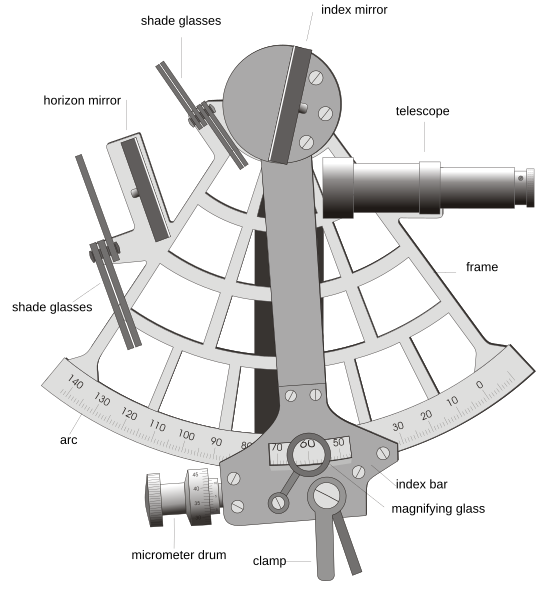A sextant is a complicated-looking device designed to do something very simple: to measure the angle between two objects.
The Sextant
image wikimedia commons
It was invented during the great age of exploration and sail, and some of the great names of science worked on it's development, including Robert Hooke, Edmond Halley (of Halley's Comet), and Isaac Newton. I could write several blog posts on it's interesting history... but that would distract us from our Hello World! problem. And that is forbidden according to the rules!
Suffice to say that the sextant evolved out of a long line of navigation instruments. It's immediate ancestor, the octant, was one of the first reflecting instruments. Reflecting instruments are so called because they used mirrors to make it easier to take measurements than earlier instruments.
Briefly, the mirrors allow a user to view two objects at the same time. That was the key innovation. The movable arm, called the index arm or bar, enables the user to align the two objects in the viewer. When the two objects are aligned, the angle between them can be read directly off the instrument.
This ease of use -- view two objects, align them in the viewer, read the angle -- forced the sextant's many competitors into extinction in just a few years. And it's never been improved upon. It was that brilliant an invention.
Here's a short demo. Study how the mirrors work.
How reflecting instruments -- like sextants -- work
demo wikipedia commons
By 'taking a sight', we mean measuring (in degrees) the height of the object above the horizon, at a specific moment in time.
The exact time of the measurement is a critical part of the measurement, because the object (eg. the Sun) is moving and it's height is constantly changing.
The height of the Sun above the horizon, measured in degrees
image jalmberg
When we take a 'sight', therefore, we always end up with two numbers:
- The height of the object above the horizon (Hs) in degrees
- The date and time of the measurement
How accurate do these numbers have to be? Well, consider these facts:
- the Sun moves over the ground at a speed of about 1000 miles per hour
- at the latitude of New York, the Sun moves westward about 0.1' per second
- the Sun's height changes (up or down) by about 0.1' every second
So, that gives you a feel for the kind of numbers we are working with: very small, changing very rapidly.
The Sun
photo wikimedia commons
Finally, we have been talking about 'taking a sight', but most of the time, we will be taking several sights. A single sight is of limited usefulness.
In particular, since we don't know the exact time of solar noon (if we did, we'd know our exact longitude, which is one of the things we are trying to determine), we are going to take not one sight, but a series of sights, starting at about 1/2 hr before estimated solar noon, and ending at about 1/2 hr after.
But this series of sights and what to do with them is interesting enough to deserve it's own post, so I will leave that until next time.
So have your graph paper ready! We'll be doing some plotting!
Speaking of next time... if you'd like to be notified when I post a new 'lesson' (erratically, about 3 times a week), you can sign up for my super-sophisticated Automatic Notification Process. Actually, it's just an email, but Automatic Notification Process sounds better. I won't spam you, and you can de-sign up at any time.
>>> Next Episode: Plotting the Sights
If you enjoyed this episode of the Unlikely Boat Builder, please consider telling a friend about it, or posting a link on Facebook. Thanks!
Get Notified Automatically
I hope you're enjoying "The Unlikely Boat Builder" as much as I enjoy writing it. Over 250 people have asked for a way to be notified automatically when I post new episodes. I've figured out how to do this, so if you'd like to be notified, please click on the link below. I promise I'll never spam you (and Google will have my head if I do.)
Thanks for your interest!
-- John
Follow me on Twitter! My son Chris has been bugging me for a few weeks to use Twitter to make short, more frequent posts from my iPhone, for when I don't have the time for longer blog posts. I don't know how it will work out, but I'm willing to give it a try! My Twitter ID is UnlikelyVoyager (UnlikelyBoatBuilder is too long, apparently), and the URL is http://twitter.com/UnlikelyVoyager. Twitter me back, or leave a comment below, if you think this is worth while. Thanks, Chris!




Nice post, very practical and so much better than all that PKX triangle theory.
ReplyDeleteI'm always happy to get a position within a couple of miles, close enough - and then switch on the GPS of course!!